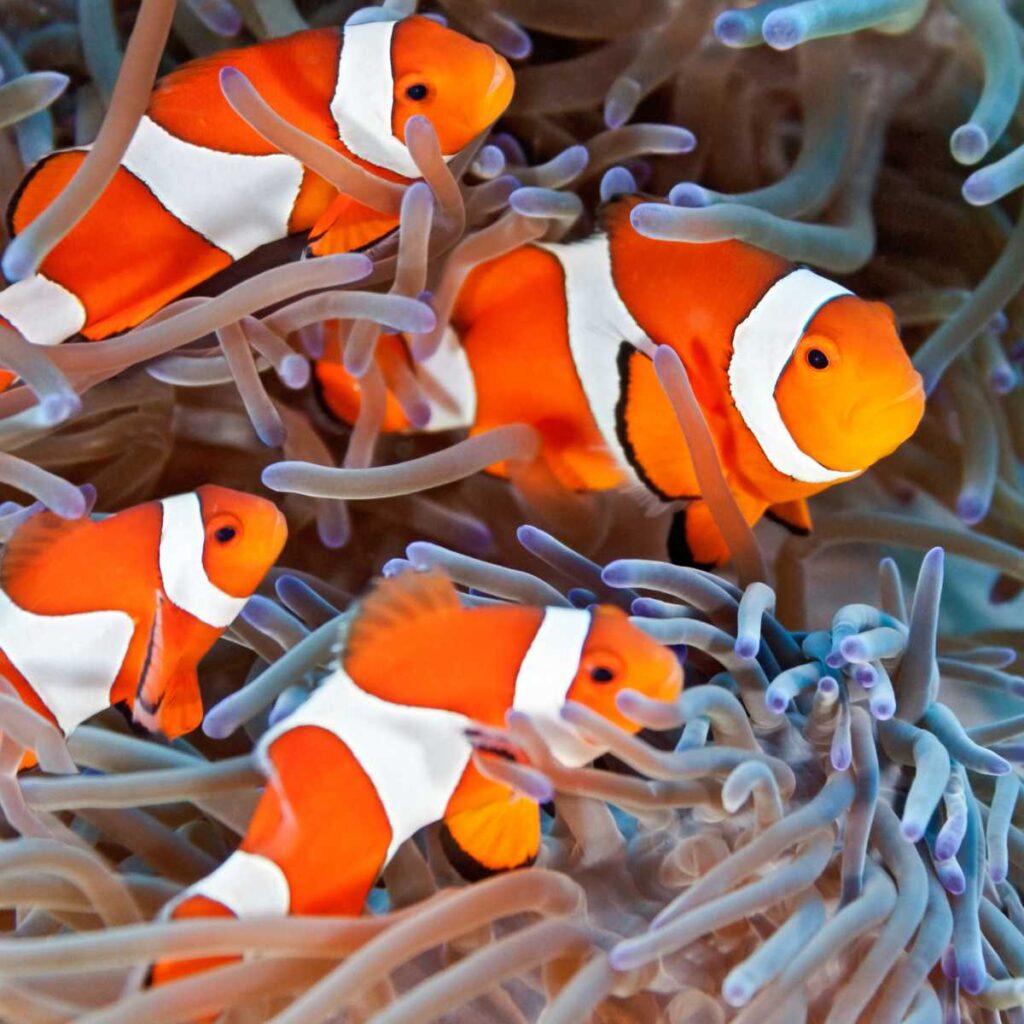Last Reviewed and Updated on February 13, 2023
Clownfish, also known as anemonefish, are one of the most well-known and recognizable tropical fish in the world. But did you know there are more than one species of clownfish, and not all look like Nemo? Read on and learn more about these colorful fish, from the basics to some fun facts about clownfish.

About Clownfish
Clownfish are a group of small, brightly colored fish known for their distinctive appearance and their symbiotic relationship with anemones. They are mostly found in the warm waters of the Indian and Pacific Oceans, usually in shallow waters and reefs.
There are 30 recognized species of clownfish, each with its own unique appearance. The species have been grouped into six complexes of clownfish (determined by visual features); percula, tomato, skunk, clarkii, saddleback, and maroon.
The most known and recognizable species of clownfish is the ocelaris clownfish (Amphiprion ocellaris), also known as the common clownfish or false fercula clownfish. This species was used as the main protagonist in the Finding Nemo franchise.
Clownfish are omnivorous and feed on algae, undigested food from anemones, planktonic crustaceans, mollusks, and small fish.
The life cycle of a clownfish begins with a fertilized egg that hatches into a larva. The larva will then settle on a suitable surface, such as a coral reef, and undergo a series of transformations until it becomes an adult fish. The entire process typically takes several weeks to several months, depending on the species of clownfish.
In general, clownfish are not endangered. However, some species are more vulnerable., especially due to environmental issues (coral reefs degradation).
Interesting Facts About Clownfish
Read through these facts about clownfish and learn what makes these fish unique.

Also read: a comprehensive list of facts about fish or our list of 100 weirdest animal facts
1. All clownfish are born male
As clownfish are sequential hermaphrodites, and they are all born male. Sequential hermaphroditism is a type of hermaphroditism in which an individual can change their sex at some point in their life. In clownfish, the sex change can only happen once in their life, and it is permanent; once a male changes to a female, it remains a female for life.
2. Females are the dominant ones and are larger than males
Clownfish live in groups with a strict hierarchy, the female is the largest in the group, and she is the dominant one. The female can be found at the top of the group, and she is the most aggressive in the group.
3. In the group, only one male gets to mate with the female
A group of clownfish had a dominant pair, only the largest and most dominant male mates with the female. Other males do not breed unless a clownfish from the breeding pair dies.
4. If the female dies, the dominant male becomes a female
This is one of the coolest facts about clownfish. If something happens to the female, either she dies or is removed from the group by other means, and the largest (dominant) male transitions into a female and becomes the breeding female of the group.
The largest juvenile male fish from the group assumes the role of the dominant breeding male.
5. Their reproductive cycle is often correlated with the lunar cycle
The reproductive cycle of clownfish is often (but not always) correlated with the lunar cycle. They can breed all year round; however, the rates of spawning peak around the first and third quarters of the lunar cycle; this results in the eggs hatching around the full moon or new moon periods.
The exact reason for this is unknown; most hypotheses revolve around the effect of tidal regimes for the dispersal of eggs and moonlight for survival rates (source).
6. Males tend to the eggs more and can control the development of eggs
Females only occasionally tend to the eggs; most of the time, the male is looking after and cares for the eggs. Males fan and guard the eggs for 6 to 10 days until the eggs hatch. The eggs will develop faster or slower depending on how the males fan the eggs (source).
7. They come in many color variations
When talking about clownfish, the most commonly referred to species is the ocellaris clownfish, an orange fish with white and black bands. But they come in many color variations and with many colors; for example, Whitesnout anemonefish is mostly black with a white head and tail, and pink skunk anemonefish is peach colored with a white stripe.

8. They protect their anemone
Besides their wonderful colors, clownfish are best known for their symbiotic relationship with anemones. The clownfish protects the anemone from its predators and parasites in return for a safe place to live in (so the anemone also protects the clownfish from predators).
9. They also clean it and feed it
The clownfish clean the anemone by eating any algae or parasites that might be living on it. The clownfish also provides the anemone with nutrients from its droppings.
10. Clownfish are immune to “their” anemone’s poison
Clownfish are immune to the poison of the anemone in which they live; a specific clownfish species will only inhabit specific anemones. There are several theories about what causes the immunity, with the most likely ones being that this is because the clownfish has a mucus coating different than other fish and anemones don’t recognize the clownfish as a potential food source or that the clownfish evolved an immunity to the toxins of the species of anemone they reside in.
